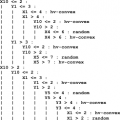You are here
Advanced Methods for Discrete Tomography with Priors and Applications

From the birth of discrete tomography several reconstruction methods have been developed for certain classes of discrete sets, all of them using some prior knowledge of the image to be reconstructed. Some of them performs the reconstruction directly while others by reformulating the problem to a global optimization task. In both cases, it is always supposed that the prior information is given explicitly. The goal of this project is to open a new direction in discrete image reconstruction, when the prior information is not explicitely available beforehand, but can be extracted from the projections themselves.
Feature selection methods and machine learning (like decision trees, neural networks, floating search methods) are robust and effective tools to detect important attributes of a given object, or to classify objects of the same type with the aid of their attributes. In discrete image reconstruction problems one can think of the projection components as the attributes of the discrete set. In this scenario – in order to facilitate the reconstruction – the task is to determine structural or geometrical properties of the discrete set from the attributes (i.e., from the projection components). In this way, in a preprocessing step we can decide which reconstruction algorithm to choose and how to parameterize it. Additionally, we can investigate which are the most important projection directions or projection components that can guarantee geometrical properties. Observations of this kind can also yield characterization results. Beside, there is a possibility to design reconstruction algorithms that can directly use the information gained from the attributes by applying techniques mentioned above. Evolutionary algorithms seem to be the most effective and flexible approach here. The aims of the project are:
- Apply and evaluate feature selection methods to obtain information purely from the projections that can facilitate the reconstruction.
- Design and implement discrete tomographic reconstruction methods that can exploit the information obtained by feature selection methods. To test these methods from the viewpoint of speed accuracy, noise-sensitivity, etc.
- Derive characterization results for some classes of discrete sets with the aid of their projections.
- Study these techniques in scenarios where the number of possible values in the reconstructed function/image is small but larger than 2.
- Devise specific settings for the reconstruction problem for particular applications.
